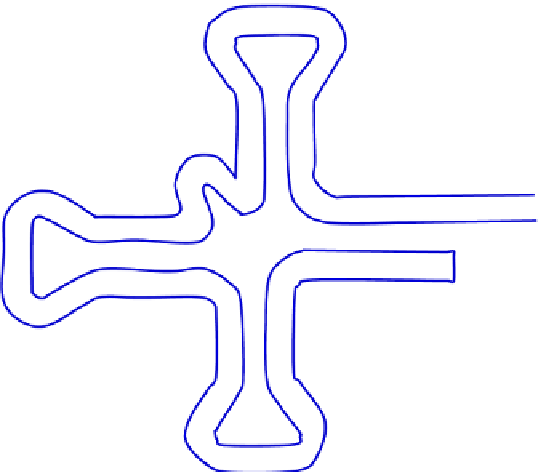Biomedical Engineering Reference
In-Depth Information
mRA
G
m
A
C
U
Codon
C
T
Anticodon
G ||| C
U ||| A
G ||| C
U ||| A
m
G
U
C
G
m
C
G
Y
phe
A A U U C G C A C C A
A
A
U |||
A
A
m
C
U G G
U |||
U U U A A G C G
A
A G A C C
m
G
m
G
m
G
C |||
m
G
C
U
C
C |||
G |||
A |||
G |||
U
A
A
G
D
G
G
G D
FIGURE 2.35
The structure of the tRNA molecule and the manner in which the anticodon of tRNA associates
with the codon on mRNA by complementary base pairing. The amino acid corresponding to this codon (UUC) is
phenylalanine that is bonded to the opposite end of the tRNA molecule. Many tRNA molecules contain unusual
bases, such as methyl cytosine (mC) and pseudouridine (
J
).
RNA molecules are usually single-stranded, except for certain viral RNA molecules contain-
ing regions of double-helical structure, resembling hairpin loops.
Figure 2.35
describes the
cloverleaf structure of transfer RNA (tRNA). In double-helical regions of tRNA, adenine
(A) base pairs with uracil (U) and guanine base (G) pairs with cytosine (C). The RNA content
of cells is usually two to six times higher than the DNA content.
Let us summarize the roles of each class of RNA:
Messenger RNA (mRNA) is synthesized in the chromosome in the nucleolus and carries
genetic information from the chromosome for synthesis of a particular protein to the ribo-
somes. The mRNA molecule is a large one with a short half-life.
Transfer RNA (t-RNA) is a relatively small and stable molecule that carries a specific amino
acid from the cytoplasm to the site of protein synthesis on ribosomes. tRNA is an adapter
molecule composed of RNA, typically of 73
e
93 nucleotides in length, that is used to bridge
the four-letter genetic code in mRNA with the twenty-letter code of amino acids in protein.
Each of the 20 amino acids has at least one corresponding type of tRNA molecule.
Ribosomal RNA (rRNA) is the major component of ribosomes, constituting nearly 65%. The
remainder is various ribosomal proteins. Threedistinct types of rRNAs present in the E. coli ribo-
some are specified as 23S, 16S, and 5S, respectively, on the basis of their sedimentation coeffi-
cients, determined in a centrifuge (the symbol S denotes a Svedberg unit). The MWs are
35 kD for 5S, 550 kD for 16S, and 1100 kD for 23S. These three rRNA types differ in their base
sequences and ratios. Eukaryotic cells have larger ribosomes and four different types of rRNAs:



























Search WWH ::

Custom Search